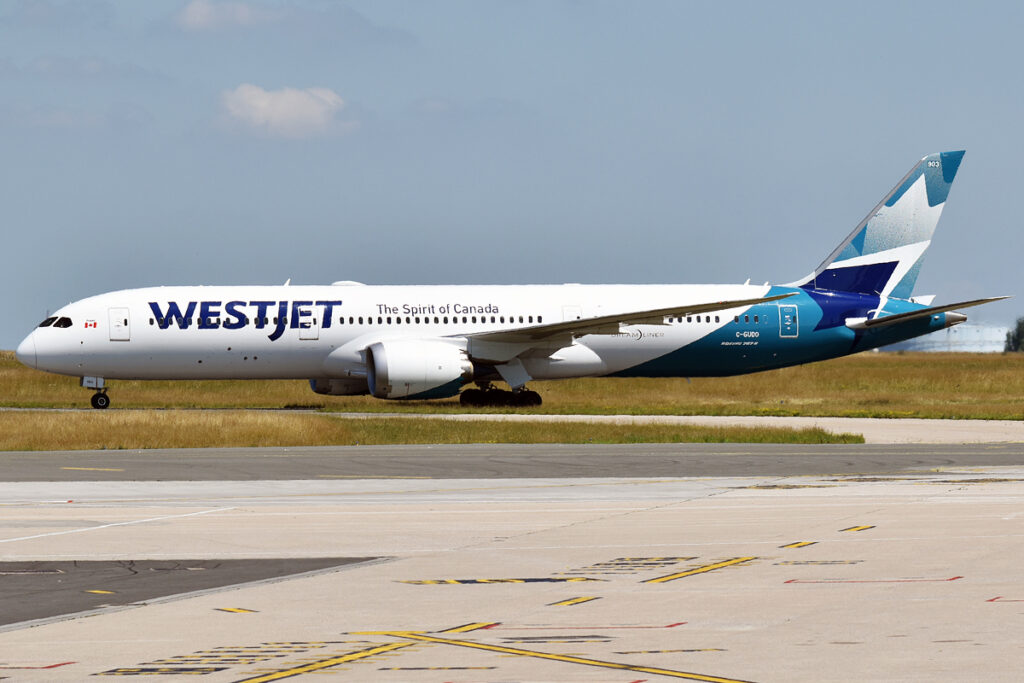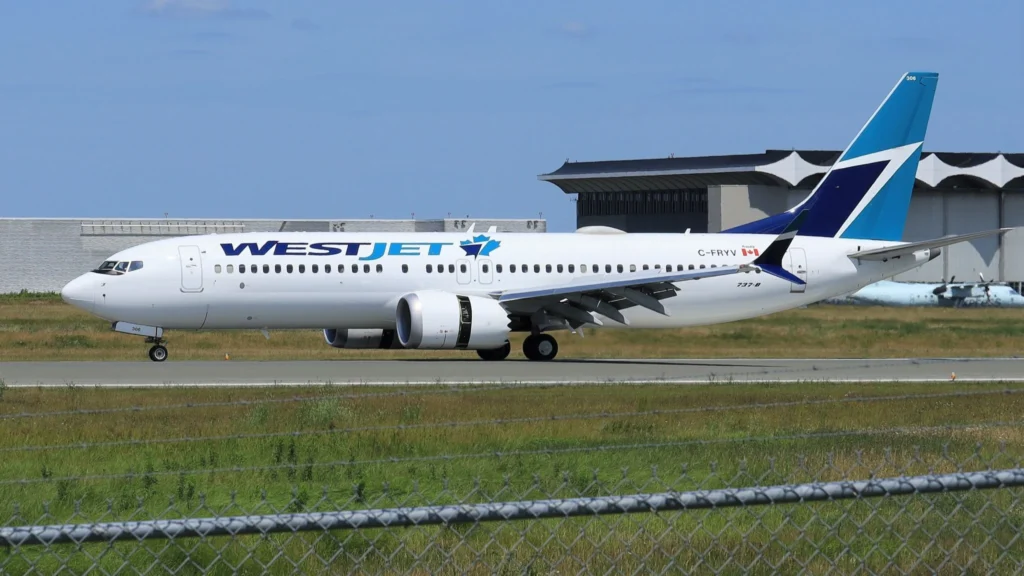
Калгари- Анализ 20 самых загруженных маршрутов WestJet (WS) показывает значительную динамику рынка по основным канадским коридорам с заметными различиями в производительности между внутренними и международными маршрутами через 3 квартал 2024 года.
Данные AvBench подчеркивают как проблемы, так и возможности в сетевой стратегии авиакомпании, особенно в ее западном канадском оплоте.
 Фото: Анна Зверева из Таллина, Эстония - WestJet, C-GUDO, Boeing 787-9 Dreamliner, CC BY-SA 2.0, https://commons.wikimedia.org/w/index.php?curid=87491707
Фото: Анна Зверева из Таллина, Эстония - WestJet, C-GUDO, Boeing 787-9 Dreamliner, CC BY-SA 2.0, https://commons.wikimedia.org/w/index.php?curid=8749170720 самых оживленных маршрутов Запада реактивный
Авиакомпания демонстрирует особенно сильные позиции на рынках Западной Канады, сохраняя доминирующие позиции более чем на 90% на таких рынках, как Келоуна-Калгари (90%) и Регина-Калгари (99%), в то время как основные трансконтинентальные маршруты демонстрируют более конкурентное давление.
В приведенной ниже таблице представлены 20 самых загруженных маршрутов WestJet (WS) пассажирами:
| 1 1 | Ванкувер-Калгари | 581 тысяча | 50% | 290 500 | 4,9% |
| 2 2 | Келоуна-Калгари | 270 тысяч | 90% | 243 тысячи | 27,3% |
| 3 | Калгари-Виктория | 260 тысяч | 89% | 231 400 | 23,1% |
| 4.4 | Торонто-Калгари | 509 000 | 37% | 188 330 | 0,7% |
| 5 | Виннипег-Калгари | 248 000 | 78% | 193 440 | 16,3% |
| 6.6 | Эдмонтон-Ванкувер | 244 000 000 | 40% | 97 600 | -1,3% |
| 7. | Регина-Калгари | 151 000 000 | 99% | 149 490 | 6,4% |
| 8 | Саскатун-Калгари | 163 000 | 98% | 159 740 | 10,9% |
| 9 9 | Эдмонтон-Виннипег | 147 000 | 85% | 124 950 | 18,4% |
| 1010 | Эдмонтон-Торонто | 243 тысячи | 30% | 72 900 | 6,5% |
| 11. | Эдмонтон-Келовна | 150 тысяч | 64% | 96,000 | 9,9% |
| 12. | Канкун-Калгари | 150 тысяч | 68% | 102 000 | 8,7% |
| 13 | Лас-Вегас-Калгари | 148 тысяч | 61% | 90 280 | 6,3% |
| 14 | Эдмонтон-Калгари | 143 000 | 59% | 84 370 | -4,3% |
| 15 | Эбботсфорд-Калгари | 148 тысяч | 51% | 75 480 | 5,0% |
| 16 | Торонто-Ванкувер | 338 тысяч | 21% | 70 980 | 0,7% |
| 177 | Канкун-Торонто | 218 тысяч | 22% | 47 960 | 6,7% |
| 18 | Торонто-Виннипег | 193 000 000 | 28% | 54 040 | 0,8% |
| 19 | Пунта Кана-Торонто | 184 000 000 | 24% | 44 160 | 13,5% |
| 20 | Орландо-Торонто | 149 000 | 22% | 32 780 | 6,6% |
1. Ванкувер (YVR) - Калгари (YYC)
- Пассажирский объем: 581 тысяча
- Доля рынка: 50%
- Пассажиры WestJet: 290 500
- Темпы роста YoY: 4,9%
Флагманский маршрут демонстрирует WestJet активно присутствует в коридоре Западной Канады, перевозя почти 300 000 пассажиров, несмотря на жесткую конкуренцию со стороны Air Canada (AC).
Сбалансированная доля рынка предполагает здоровую конкурентную среду, в то время как положительные темпы роста указывают на устойчивый спрос.
Маршрут выгоден как для бизнеса, так и для отдыха, соединяя два крупных экономических центра, в то же время служа важным связующим пунктом для международных путешественников через оба хаба.
2. Kelowna (YLW) - Calgary (YYC)
- Пассажирский объем: 270 тысяч
- Доля рынка: 90%
- Пассажиры WestJet: 243 тысячи
- Темпы роста YoY: 27,3%
Почти монополия WestJet на этом маршруте демонстрирует ее доминирование на региональных рынках Западной Канады, причем значительный рост в годовом исчислении свидетельствует о высоком спросе и успешном управлении производственными мощностями.
Успех маршрута обусловлен как развлекательным трафиком в долину Оканаган, так и деловыми связями через хаб Калгари, что демонстрирует способность WestJet эффективно обслуживать несколько сегментов рынка.
3. Калгари (YYC) - Виктория (YYJ)
- Пассажирский объем: 260 тысяч
- Доля рынка: 89%
- Пассажиры WestJet: 231 400
- Темпы роста YoY: 23,1%
Еще одна демонстрация региональной силы WestJet, этот маршрут показывает исключительный рост, сохраняя при этом доминирующую долю рынка.
Высокий пассажиропоток отражает высокий спрос между крупнейшим городом Альберты и столицей Британской Колумбии.
Впечатляющие темпы роста предполагают успешное расширение мощностей и сильное признание рынка услуг WestJet на этом маршруте.
4. Торонто (YYZ) - Калгари (YYC)
- Пассажирский объем: 509 000
- Доля рынка: 37%
- Пассажиры WestJet: 188 330
- Темпы роста YoY: 0,7%
Этот крупный трансконтинентальный маршрут сталкивается с жесткой конкуренцией со стороны Air Canada (AC), что отражается в более низкой доле рынка.
Скромные темпы роста говорят о зрелом рынке с установившейся конкурентной динамикой. Маршрут служит важным связующим звеном между Востоком и Западом в сети WestJet, связывая его хаб в Калгари с Торонто, крупнейшим городом и финансовым центром Канады.
5. Виннипег (YWG) - Калгари (YYC)
- Пассажирский объем: 248 000
- Доля рынка: 78%
- Пассажиры WestJet: 193 440
- Темпы роста YoY: 16,3%
Сильное присутствие WestJet в этом прерийном коридоре видно из его высокой доли рынка и здоровых темпов роста.
Маршрут выигрывает от трафика между точками и соединений через Калгари. Впечатляющие темпы роста указывают на успешное стимулирование рынка и, возможно, увеличение доли рынка у конкурентов.
6. Эдмонтон (YEG) - Ванкувер (YVR)
- Пассажирский объем: 244 000 000
- Доля рынка: 40%
- Пассажиры WestJet: 97 600
- Темпы роста YoY: -1,3%
Этот конкурентный маршрут показывает, что WestJet сохраняет значительное присутствие, несмотря на сильную конкуренцию со стороны Air Canada (AC) и Flair Airlines (F8). Отрицательные темпы роста свидетельствуют о некотором давлении на долю рынка со стороны ультра-дешевых перевозчиков.
Маршрут обслуживает рынки бизнеса и отдыха, соединяя столицу Альберты с тихоокеанскими воротами Канады.
7. Regina (YQR) - Calgary (YYC)
- Пассажирский объем: 151 000 000
- Доля рынка: 99%
- Пассажиры WestJet: 149 490
- Темпы роста YoY: 6,4%
Виртуальная монополия WestJet на этот маршрут демонстрирует ее абсолютное доминирование в соединении вторичных рынков прерий. Здоровые темпы роста свидетельствуют о сохранении рыночной силы и эффективном управлении производственными мощностями.
Успех маршрута демонстрирует способность WestJet эффективно обслуживать небольшие рынки, сохраняя при этом прибыльные операции.
8. Саскатун (YXE) - Калгари (YYC)
- Пассажирский объем: 163 000
- Доля рынка: 98%
- Пассажиры WestJet: 159 740
- Темпы роста YoY: 10,9%
Подобно Regina, этот маршрут демонстрирует доминирование WestJet на рынках Саскачевана. Сильные темпы роста предполагают успешное развитие рынка и, возможно, увеличение частоты или мощности.
Высокая доля рынка свидетельствует о сильных предпочтениях бренда и эффективных конкурентных барьерах на рынке.
9. Edmonton (YEG) - Winnipeg (YWG)
- Пассажирский объем: 147 000
- Доля рынка: 85%
- Пассажиры WestJet: 124 950
- Темпы роста YoY: 18,4%
Этот коридор показывает силу WestJet в соединении крупных городов прерий. Впечатляющие темпы роста свидетельствуют об успешном стимулировании рынка и, возможно, о новых частотных добавлениях.
Высокая доля рынка свидетельствует о сильной конкурентной позиции и эффективном сетевом планировании в обслуживании этих рынков.
10. Эдмонтон (YEG) - Торонто (YYZ)
- Пассажирский объем: 243 тысячи
- Доля рынка: 30%
- Пассажиры WestJet: 72 900
- Темпы роста YoY: 6,5%
Этот трансконтинентальный маршрут сталкивается с сильной конкуренцией со стороны Air Canada и новых сверхдорогих перевозчиков. Низкая доля рынка отражает конкурентный характер рынков городских пар.
Положительные темпы роста свидетельствуют о некотором успехе в увеличении доли рынка, возможно, благодаря стратегическому планированию и инициативам по ценообразованию.
11. Edmonton (YEG) - Kelowna (YLW)
- Пассажирский объем: 150 тысяч
- Доля рынка: 64%
- Пассажиры WestJet: 96,000
- Темпы роста YoY: 9,9%
WestJet занимает прочную позицию на этом маршруте, соединяющем Альберту с винодельческой страной Британской Колумбии.
Здоровые темпы роста указывают на успешное стимулирование рынка и, возможно, увеличение сезонных мощностей. Маршрут выигрывает как от отдыха, так и от посещения друзей и родственников (VFR), с сильными сезонными пиками.
12. Канкун (CUN) - Калгари (YYC)
- Пассажирский объем: 150 тысяч
- Доля рынка: 68%
- Пассажиры WestJet: 102 000
- Темпы роста YoY: 8,7%
Этот международный маршрут досуга демонстрирует силу WestJet в соединении Западной Канады с солнечными направлениями.
Сильная доля рынка свидетельствует об успешной конкуренции как с канадскими, так и с мексиканскими перевозчиками. Прочные темпы роста предполагают эффективное управление производственными мощностями и высокий спрос на рынке досуга.
13. Лас-Вегас (LAS) - Калгари (YYC)
- Пассажирский объем: 148 тысяч
- Доля рынка: 61%
- Пассажиры WestJet: 90 280
- Темпы роста YoY: 6,3%
Еще один сильный международный маршрут досуга, показывающий способность WestJet эффективно конкурировать на рынке США. Приличная доля рынка отражает успешное позиционирование против канадских и американских перевозчиков.
Положительные темпы роста указывают на устойчивый спрос на туристические поездки и успешные стратегии стимулирования рынка.
14. Эдмонтон (YEG) - Калгари (YYC)
- Пассажирский объем: 143 000
- Доля рынка: 59%
- Пассажиры WestJet: 84 370
- Темпы роста YoY: -4,3%
Этот короткий маршрут сталкивается с конкуренцией как с воздушным, так и с наземным транспортом. Негативные темпы роста могут отражать усиление конкуренции со стороны ультра-дешевых перевозчиков или изменения в поведении потребителей.
Маршрут имеет стратегическое значение для подключения к сети, несмотря на проблемы на местном рынке.
15. Abbotsford (YXX) - Calgary (YYC)
- Пассажирский объем: 148 тысяч
- Доля рынка: 51%
- Пассажиры WestJet: 75 480
- Темпы роста YoY: 5,0%
Этот маршрут служит альтернативным выходом на рынок Ванкувера, обслуживая местный спрос в долине Фрейзер.
Сбалансированная доля рынка отражает конкуренцию со стороны ультра-дешевых перевозчиков. Положительные темпы роста свидетельствуют об успешном развитии рынка и эффективном позиционировании против недорогих конкурентов.
16. Торонто (YYZ) - Ванкувер (YVR)
- Пассажирский объем: 338 тысяч
- Доля рынка: 21%
- Пассажиры WestJet: 70 980
- Темпы роста YoY: 0,7%
Этот крупный трансконтинентальный маршрут сталкивается с интенсивной конкуренцией со стороны нескольких перевозчиков. Низкая доля рынка отражает высококонкурентный характер этого маршрута.
Скромные темпы роста предполагают сосредоточение внимания на управлении доходностью, а не на росте доли рынка в этом конкурентном коридоре.
17. Канкун (CUN) - Торонто (YYZ)
- Пассажирский объем: 218 тысяч
- Доля рынка: 22%
- Пассажиры WestJet: 47 960
- Темпы роста YoY: 6,7%
Этот конкурентоспособный маршрут отдыха сталкивается с сильной конкуренцией со стороны Air Canada и туристических перевозчиков. Низкая доля рынка отражает интенсивную конкуренцию на рынке Торонто-Кариб.
Положительные темпы роста указывают на успешное позиционирование рынка, несмотря на конкурентное давление.
18. Торонто (YYZ) - Виннипег (YWG)
- Пассажирский объем: 193 000 000
- Доля рынка: 28%
- Пассажиры WestJet: 54 040
- Темпы роста YoY: 0,8%
Этот маршрут соединяет крупнейший город Канады с крупным центром прерий. Умеренная доля рынка отражает сильную конкуренцию со стороны Air Canada и новых перевозчиков.
Скромные темпы роста свидетельствуют о стабильной, но высококонкурентной рыночной среде.
19. Пунта-Кана (PUJ) - Торонто (YYZ)
- Пассажирский объем: 184 000 000
- Доля рынка: 24%
- Пассажиры WestJet: 44 160
- Темпы роста YoY: 13,5%
Этот туристический маршрут показывает сильный рост, несмотря на сильную конкуренцию. Низкая доля рынка отражает присутствие нескольких перевозчиков на рынке Торонто.
Впечатляющие темпы роста предполагают успешное стимулирование рынка и, возможно, увеличение сезонных мощностей.
20. Орландо (МКО) - Торонто (YYZ)
- Пассажирский объем: 149 000
- Доля рынка: 22%
- Пассажиры WestJet: 32 780
- Темпы роста YoY: 6,6%
Этот туристический маршрут сталкивается с конкуренцией со стороны как канадских, так и американских перевозчиков. Низкая доля рынка отражает высококонкурентный характер рынка Торонто-Флорида.
Положительные темпы роста указывают на успешное позиционирование на рынке и, возможно, повышенное внимание к развитию досуга.
 Фото: Маккензи Коул | Flickr
Фото: Маккензи Коул | FlickrАнализ эффективности рынка
Западно-канадские маршруты являются оплотом WestJet, причем восемь из 20 лучших маршрутов поддерживают долю рынка выше 60%.
Маршруты Келовна-Калгари и Калгари-Виктория демонстрируют значительный рост в годовом исчислении на 27,3% и 23,1% соответственно, что свидетельствует об успешном проникновении на рынок и оптимизации услуг на этих рынках.
Основные маршруты с востока на запад представляют собой более сложную картину: Торонто-Калгари, второй по загруженности маршрут с 509 000 пассажиров, занимает 37% рынка и демонстрирует скромный рост на 0,7% в течение 12 месяцев.
Маршрут Ванкувер-Калгари, несмотря на то, что это самый большой маршрут с 581 000 пассажиров, в последнем квартале снизился на 3,0%, сохранив при этом 50% доли рынка.
Международные маршруты эффективности
Международные маршруты, ориентированные на отдых, демонстрируют различные уровни производительности:
- Канкун-Торонто сохраняет устойчивый рост с улучшением на 6,7% в годовом исчислении
- Punta Cana-Toronto демонстрирует высокие показатели роста на 13,5%
- Лас-Вегас-Калгари сталкивается с встречным ветром с ежеквартальным снижением на 6,4%, несмотря на устойчивый ежегодный рост
Сетевая стратегия WestJet сосредоточена на укреплении своего присутствия в Западной Канаде при сохранении стратегических позиций на конкурентных трансконтинентальных рынках.
Способность авиакомпании поддерживать высокую долю рынка на региональных маршрутах, конкурируя на основных рынках, демонстрирует сбалансированный подход к развитию сети.
Оставайтесь с нами. Следуйте за нами в социальных сетях для последних обновлений.
Присоединяйтесь к нам в Telegram Group для последних обновлений авиации. Следуйте за нами в Google News
WestJet добавил 11 новых маршрутов к лету 2025 года
Топ-20 самых оживленных маршрутов WestJet впервые появился на Aviation A2Z.













